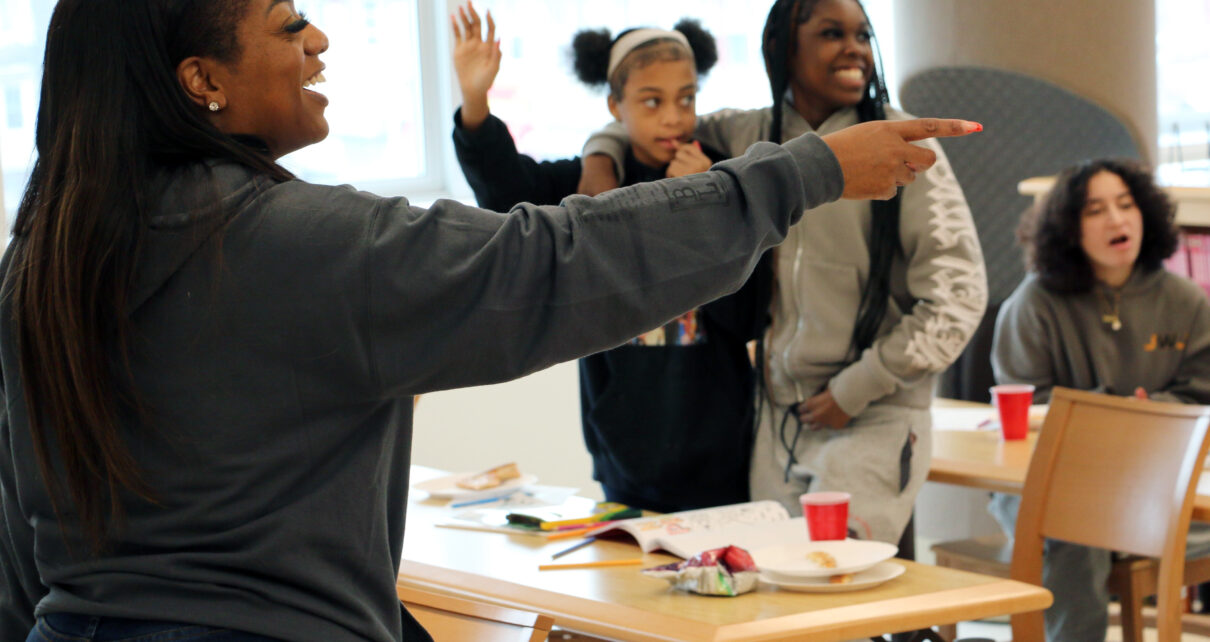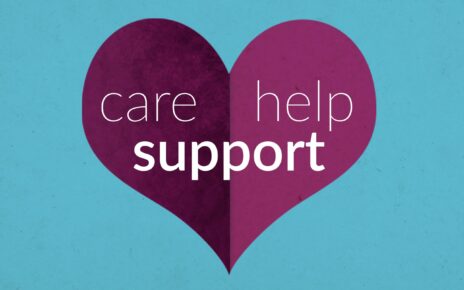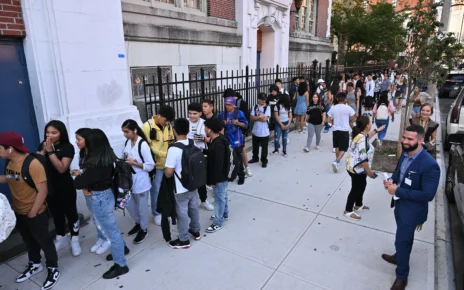
For Black students like Yanie, center, discussing their mental health and trauma in their lives can be especially difficult. A peer-mentoring program piloted last year by the East Orange, New Jersey school district — which Yanie participated in — aims to support students like her. (Sarah Blesener for Chalkbea
When a friend asked Yanie to speak at a forum on youth mental health last summer, she politely declined.
The 17-year-old didn’t doubt the urgency of the issue, especially for her peer group. More than half of Black teen girls reported feeling sad or hopeless in 2021, and nearly 1 in 5 attempted suicide — more than most other racial groups. Among Black boys and girls, the suicide rate rose every year from 2003 to 2017.
The sticking point for Yanie, whose last name Chalkbeat is withholding to protect her privacy, was discussing the issue publicly. Not only is there still stigma attached to mental illness, but also it’s often seen as a white-people problem. As Yanie saw it, Black youth are expected to “suck it up” or “fight their way out of trauma” — not talk about their problems.
 Experts say many Black teenagers like Yanie are expected to simply overcome or fight through their trauma, instead of being given the space to talk about them in a healthy and safe environment. (Sarah Blesener for Chalkbeat)
Experts say many Black teenagers like Yanie are expected to simply overcome or fight through their trauma, instead of being given the space to talk about them in a healthy and safe environment. (Sarah Blesener for Chalkbeat)
But efforts are underway to promote a different message: that it’s healthy and liberating for Black young people to open up about their struggles.
In East Orange, New Jersey, the predominantly Black city where Yanie lives, city officials made mental health the focus of a summer youth-employment program, which resulted in the student-led forum. The school district has embraced social-emotional learning to help students explore their inner lives. And last school year it piloted a peer-mentoring program where high schoolers talked to middle school students about understanding their anger and finding joy.
Such efforts are partly a pragmatic response to mental health staff shortages hobbling high-needs school districts like East Orange, where 83% of students are Black and just over half come from low-income households. But officials also want to establish new norms so that Black students, who are about half as likely as their white peers to receive mental health care, feel empowered to speak up and seek help.
“In our community, it’s a stigma that comes with that,” said Jamila Davis, an activist and educator based at Seton Hall University who helps facilitate the youth mental health programs in East Orange. “But if you see everybody around you is feeling similar things, you feel like you’re not alone and it’s OK.”
Eventually, the friend asked again, and Yanie reluctantly agreed to join an on-stage discussion at the mental health forum last August.
In an auditorium filled mostly with Black teens, her peers spoke about the psychic strain of watching videos of police brutalizing Black people, of losing loved ones to gun violence, of being mocked by classmates or brushed off by parents after sharing their struggles. Some recalled cutting themselves, binge eating, and staying in psychiatric hospitals.
One young woman explained how, for Black and Brown students, racism compounds the pain of adolescence.
“If people see that they’re not accepted in society,” she said, “how can you accept yourself?”
Yanie listened silently, debating whether to speak.
Black youth face unique challenges
Young people’s ailing mental health is “the defining public health crisis of our time,” U.S. Surgeon General Vivek Murthy recently declared. But too often the crisis’ causes and solutions are treated as universal, with race either ignored or white children’s experiences presented as the norm, said Amanda Calhoun, a psychiatry resident at Yale University.
“You’re reading about this youth mental health crisis,” she said, “and racism isn’t mentioned, the particular experiences of Black children aren’t mentioned.”
Black youth endure unique hardships in addition to the larger forces, such as social media and the pandemic, eroding young people’s mental health. They are likely to face direct discrimination as well as “vicarious racism,” which stems from seeing other Black people subjected to racial abuse. And institutional racism, such as housing discrimination and neighborhood disinvestment, puts Black youth at greater risk of poverty and violence.
Those overlapping stressors chip away at Black children’s mental health, yet many don’t receive the mental health support they need. The cost of care and social stigma can be barriers to treatment, along with mistrust of the mental health care system, in which the vast majority of providers are white and often untrained in addressing racism’s steep toll.
Given that racism is “such a huge part of Black Americans’ experience,” Calhoun said, “Why would you remain in therapy if the person has no training in racism?”
 Initially, Yanie did not want to talk to her peers about the trauma in her life. But eventually, at a youth forum, she discussed how she often felt sadness and rage and often “did not want to see myself on this earth.” (Sarah Blesener for Chalkbeat)
Initially, Yanie did not want to talk to her peers about the trauma in her life. But eventually, at a youth forum, she discussed how she often felt sadness and rage and often “did not want to see myself on this earth.” (Sarah Blesener for Chalkbeat)
Many educators also are ill-equipped to respond to mental health challenges. When Black students display common symptoms of adolescent anxiety and depression, which can include anger and hostility, they’re often perceived as “bad kids” and punished instead of supported, Calhoun said.
“These are struggling kids,” she said. “They don’t need discipline, they need help.”
One way to help is to encourage students to explore the painful emotions that can trigger unwelcome behaviors, experts say. Fellow students can support that process just by listening.
“It’s like you want somebody to hear you,” Yanie said, “to know that you’re not alone.”
A student finds power in sharing her story
Hearing her peers speak candidly about their mental health struggles at the forum inspired Yanie to defy her own reticence and speak.
“Good morning, guys,” she said into a microphone. “My name is Yanie, and this is a trauma story that I have never talked to anyone about.”
She was often unhappy as a child, she said, and by age nine was engaging in self-harm and considering suicide.
“It was very hard for me,” she told the audience, “to the point where I did not want to see myself on this earth.”
She explained how she used to alternate between sadness and rage, which she attributed to being a “hothead.” No one told her that depression often manifests as anger.
“If you are struggling with something on the inside, that anger, that being a ‘hothead,’ gives you an opportunity to express it and call attention to it,” said Michael A. Lindsey, dean of New York University’s social work program.
 Yanie, second from right, navigated the isolation and frustration she felt during the pandemic with the help of friends. Eventually, she participated in a program where she met Jamila Davis, an instructor with the program who grew to understand how trauma had shaped Yanie’s approach to life. (Patrick Wall / for Chalkbeat)
Yanie, second from right, navigated the isolation and frustration she felt during the pandemic with the help of friends. Eventually, she participated in a program where she met Jamila Davis, an instructor with the program who grew to understand how trauma had shaped Yanie’s approach to life. (Patrick Wall / for Chalkbeat)
In sixth grade, Yanie’s anger boiled over. She fought another student and was sent to an alternative school, Fresh Start Academy, for students with academic and behavioral challenges. She entered a traditional high school in ninth grade, but got into another altercation and was sent back to Fresh Start in early 2020.
Pandemic shutdowns began soon after. Yanie’s campus remained closed for more than a year, well after more affluent schools reopened. While her mother continued going to work at a nursing home, Yanie looked after her two younger brothers.
School had been her escape from home; now she was trapped there. She descended into a deep depression, barely eating or leaving her room. Yanie’s two best friends helped pull her through, calling constantly to check in and cheer her up.
“Without them,” she said, “I would be nothing.”
Yanie also found some relief from the boredom and isolation through a virtual summer and after-school program. Run by the city of East Orange, in partnership with the school district and Seton Hall University, it paid students stipends to learn life skills: how to run a small business, advocate for social causes, meditate, and process their emotions.
One of the instructors was Jamila Davis. She was previously incarcerated, and drew on the experience to teach about healing from trauma. When she first met Yanie, she sensed that her toughness was a survival strategy born of a painful past. Now she watched with awe as Yanie removed that emotional armor during the mental health forum, sharing how hopeless and resentful she once felt.
 Jamila Davis, an educator at Seton Hall University, helps facilitate a peer-mentoring program that the East Orange, New Jersey school district piloted last year to help students improve their mental health and deal with trauma. (Patrick Wall for Chalkbeat)
Jamila Davis, an educator at Seton Hall University, helps facilitate a peer-mentoring program that the East Orange, New Jersey school district piloted last year to help students improve their mental health and deal with trauma. (Patrick Wall for Chalkbeat)
“This is real,” Davis told the audience after Yanie spoke. “This is something that folks in Black and Brown communities go through on a regular basis.”
She asked if any of the students in the audience could relate to Yanie’s experience, and a sea of hands shot up. In that moment Yanie understood the power of sharing her story with peers — the validation, connection, and healing it can beget.
“I have never felt the way that I did when I was on that stage,” she said a few days later. “It filled me with so much energy and confidence.”
Students help one another improve their mental health
A few months after the forum, the school district piloted a peer-mentoring program.
The idea for it sprang from high schoolers in Davis’ life-skills class who said they wanted to pass on what they had learned. So Davis and Juan Rios, a Seton Hall social work professor, developed a course that trained students how to talk to their peers about mental health.
East Orange School District Superintendent AbdulSaleem Hasan and Kelly Williams, director of student support services, made the mental health peer-coaching course available to high schoolers. Later, after school social worker Lita King-Morton suggested having the peer coaches mentor her students, the district ran with the idea: A small group of high schoolers from Fresh Start Academy was recruited to mentor middle school students at Sheila Y. Oliver Academy who had fallen off track.
Yanie was selected as one of seven mentors. After a chaotic start to high school, she had found her footing and by senior year was thriving — she led the student council, played volleyball and softball, and was headed to college.
The officials hoped the younger students would be inspired by Yanie and the other mentors, who in turn would feel motivated to keep working on themselves.
“Becoming a better person and then teaching that, it makes you accountable,” said Davis, whom the district tapped to lead the program. “You can’t tell somebody to do something that you’re not doing.”
The program kicked off on a frigid January morning at the Oliver school library. A few seventh- and eighth-graders huddled together at a back table while the Fresh Start students spread out up front.
Davis told the group how her personal transformation began when she confronted the trauma that had led her to prison. She challenged the students to undertake their own self-discovery.
Next, the mentors explained how rage and frequent fights had led them to Fresh Start. Davis then pushed the group to consider the source of their anger, asking who had experienced trauma. Every hand shot up.
A ninth grader said he started acting out after his grandmother died. “I was angry all the time,” he said. “I used to fight a lot, and I used to curse people out a lot.”
“That’s why I tell people never judge a book by its cover,” Davis told the students. “Somebody may judge you, they may put a label on you, but they don’t know that you’re hurting inside.”
Eventually the high schoolers paired up with mentees. Yanie found an eighth grader who was sitting alone. The girl had a surly demeanor, but that didn’t deter Yanie, who was reminded of how she once hid her own hurt behind a hostile exterior. “She’s literally a mini-me,” Yanie thought.
Yanie began looking forward to Mondays, when a yellow school bus shuttled the high schoolers to Oliver Academy. She found that her past struggles helped her understand and advise her mentee, whose own quick temper sometimes got her into trouble.
When the younger girl began bickering with a classmate during one session, Yanie stepped in. “Let’s practice kindness,” she said gently.
Another day, Yanie shared ways she finds joy — listening to hip hop and soul music, reading scary books. Then she asked what makes her mentee happy.
“Not being here,” the girl said.
“Do you hate school?” Yanie asked.
“I like school, but I don’t like the people in school,” the girl replied.
Yanie kept drawing her out until the girl revealed that her mother had died some time ago. As with Yanie, her anger drew from a deep well of pain.
 In the past school year, Yanie served as a mentor to an eighth grade student with a quick temper who disliked people in her school. Over time, through various activities like painting, Yanie helped the mentee discuss her mental health and think about how she could change her behavior. (Sarah Blesener for Chalkbeat)
In the past school year, Yanie served as a mentor to an eighth grade student with a quick temper who disliked people in her school. Over time, through various activities like painting, Yanie helped the mentee discuss her mental health and think about how she could change her behavior. (Sarah Blesener for Chalkbeat)
With their mentors’ encouragement, the middle schoolers began opening up about their mental health and rethinking old patterns of behavior.
One morning in February, after a freshman boy kept interrupting Yanie’s conversation with her mentee, the girl snapped at him. “Can you shut up so she can speak!”
But then she looked at Yanie and tried again. “I mean, excuse me,” she said to the boy, considering each word. “Can you please be quiet?” Yanie smiled and gave her a high five.
The mentoring ended in April, but the district plans to continue the program this school year with a new crop of students. One of the program’s objectives had been to bolster the mentors’ sense of purpose and self-worth, and Yanie had felt that change in herself. She imagined visiting her childhood self, who had seen only darkness on the horizon, to show her the person she’d become.
“Nine-year-old me would be looking at me right now,” Yanie said, “and I could really say she’d be proud of me.”
At the final mentoring session, the students painted portraits of their partners along with words describing them. Yanie’s mentee almost never spoke to the full group, but that day she stood at the front of the school library next to Yanie and read the words she’d painted for her mentor: kind, outgoing, smart, brave.
“And what does she mean to you?” Davis asked.
The girl reached out and put her hand on Yanie’s shoulder. “A lot,” she said.
If you or someone you know is having thoughts of suicide, call or text 988 to reach the 988 Suicide and Crisis Lifeline or visit 988lifeline.org to find more resources.







